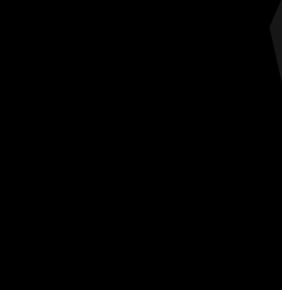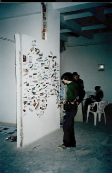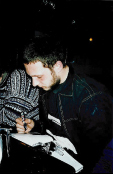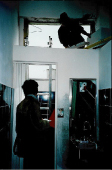H.Arta is an alternative space in Timisoara;
it is a mobile space, with a clear concept; it is not just a space, but also
a project in itself, changing its look and developing together with the projects
it presents. H.Arta is a place for meeting and it has large windows; it is
a place for talking and it has a good resonance; it is a place for exchanging
ideas and it's run by a group of artists; it is a place for changing pre-conceived
ideas and it has as neighbors a cemetery and a gas station; it is a place
for exhibiting shaped ideas, and it has inspiring walls.
H.Arta is mapping some of the not well-established paths in contemporary local
and regional art. It tries to ask questions to the young artists and their
public and to determine them to answer to themselves. H.Arta does not create
artificial issues, but brings into debate its immediate context.
"Media, Art and Gender" was a workshop organized as a creative response to this context.
…a quantity of pictures; media representations of gender, presentation of these representations; material offered in order to create a visual aggression upon the participant; the first reaction: a sensation of whirling; generous subject, beautiful women, artificial women, patterns of beauty, Eastern women having to conform to the Western types…
First thing to be seen - a lot of images, virtually containing a lot of possibilities of interpretation and a lot of paths for the discussions; then, the other walls, empty, and then the workers with the noise; Barbara Kruger's "your body is a battleground" was like a menacing statement, as it concentrated all the mental images created on the announcement of the subject. H.Arta space had become a battleground itself.
All the images had to be taken out of their floating condition and put to a narrower and more concluding ground; the surroundings were constituted by the post-socialist countries; those countries where the image of woman has been associated with that of the mother and of the homeland, and also that of the activist, masculine woman. But the question of gender was discussed from a larger point of view than that of feminism; the image of the mother-nation was put into relation with that of the political portrait of men-leaders.
To write an article about that workshop is like the workshop itself: the challenge of putting together, in a sensed way, all the pieces of memory…
The progress of the workshop: first, the
people that didn't know each other, the amount of disorganized images, the
temptation of the ancient pictures prepared for Smaranda Vultur's presentation,
the theoretical frame bringing new knowledge, the noise made by the workers…
Secondly, the Serbian artists, who brought a change into the program. Thirdly,
the organizers trying to re-position themselves.
And then, everything began to connect, the noise became soundtrack, the information
started to speak for its own, the media images became familiar and people
got the courage to change their display, the Serbians' project provoked other
talks and private stories that were put into contact with the public and artificial
stories of media.
Rodica - the one who remained lucid all along the event; Mariuca - the organizer-animator; Anca - the cheerful element at any time, also the speaker ("the presiding officer of a deliberative assembly"); Rares - he calls himself a visionary artist; Ioana - the picking and re-arranging one; Gabi the poet; Alin - the documentary man; Maja - the ironical, wearing her special T-shirts and bags; Marija - the frail one, also a sculptor, who would have believed that?; Gabrijel - constructing an enigmatic image of himself; Danica - the one succeeding in being ubiquitous; Aura - thinking about the shape of the exhibition…
The obsessing images, the intriguing images, the re-re-arranged images, the post-socialist context, the "post-feminism", "the post-democracy", the de-contextualised images, the de-fragmented images, the de-capitated images, the delayed post-socialism, the late post-modernism, the return to the modernism, the shocking stories of the women deported from Banat to Russia, the portraits of Ceausescu and Tito, the French Liberty and the Revolutionary Romania - from the presentations to the pictures in the background, from the discussions to the working with the given material, everything was captured in a continuous flux.
- Jelica Radovanovic and the mother-to-daughter transmitted memory - an emblematic image, which one could either reject, or become completely attached to it…
The culture-jammers were following us in the quest for pictures in town; media, art and something…, media changes and de-forms everything; every act of becoming conscious of the media invasion and intrusion into one's privacy is an artistic act through that it becomes an act of resistance; the artistic resistance and the heroic resistance have in common their power of synthesis and their ironic detachment.
The issue of gender did not become secondary in this media monopoly, but subtly infiltrated into the discussions and into the works, pointing to such recurrent elements as difference, irreconcilable difference, insignificant difference, dialogue, pairs, correspondences, where is it the gender discrimination and where is it the lack of education, emancipated women and their relation to tradition, artists and manual work…
The game of assuming the gender responsibilities: women cleaning the toilet - men putting the windows; women sticking images to the wall - men photographing and filming; women putting other women on T-shirts - men voting…
Was it a game or an accepted state of facts?
The act of writing after the workshop: a
process of putting together pieces of memory, like in a puzzle, and the missing
piece is the answer to this final question, which does not require actually
an answer, as the whole point was to create some connections and some knots
of a network.
A complete puzzle is the proof of a rational intervention. A puzzle with a
missing piece is a complete work of art.
Raluca Voinea
Raluca Voinea asks, H.arta answers:
1. Did each of you assume a certain role during the workshop?
We didn't take it that way, that each of us should assume a certain role.
On the other hand, the workshop itself took place in a different way than
the predicted one, so practically, our "roles" have been different
according to the moment (organization, discussions, mediating, clarifying
the disputes, preparing the space, etc.).
2. How did you feel as organizers?
Even if there have been enough moments of stress, still, it was a good experience
for us to organize this workshop.
3. Do you think of continuing this project?
The project Media, Art and Gender is closed, but the issue in itself is part
of the contemporary and it's still interesting to us.
4. How would you define your workshop by
comparing it to other events of the same kind?
It's difficult to make a comparison, as just few events happen in Romania
connected to this issue, and anyway few events of contemporary art in general.




















